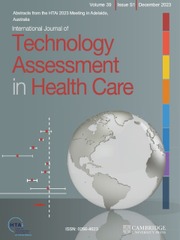Article contents
Clinical-effectiveness and cost-effectiveness of neonatal screening for inborn errors of metabolism using tandem mass spectrometry: A systematic review
Published online by Cambridge University Press: 02 March 2005
Abstract
Objectives: The clinical- and cost-effectiveness of tandem mass spectrometry (MS)-based neonatal screening for inborn errors of metabolism (IEM) were evaluated.
- Type
- TECHNOLOGY ASSESSMENT REPORTS
- Information
- International Journal of Technology Assessment in Health Care , Volume 21 , Issue 1 , January 2005 , pp. 150
- Copyright
- © 2005 Cambridge University Press
Objectives: The clinical- and cost-effectiveness of tandem mass spectrometry (MS)-based neonatal screening for inborn errors of metabolism (IEM) were evaluated.
Methods: Fourteen electronic bibliographic databases covering biomedical, science, economic, and gray literature; the reference lists of relevant articles and abstracts of conference proceedings; and eighteen health services research-related resources served as data sources. This review is an update of two previous health technology assessment reports of neonatal screening for IEM. These reports have been updated by a systematic review of published research (between 1995 and January 2002) on neonatal screening of inherited metabolic disorders using tandem MS. This update was supplemented by a search for economic literature and the application of a modeling exercise to investigate the economics of using tandem MS within a neonatal screening program in the United Kingdom.
Results: Evidence from the reviews of IEM found that the UK screening program for phenylketonuria (PKU) was well established and that there was universal agreement that neonatal screening for PKU was justified. Of the many other disorders that can be detected by tandem MS, the best candidate condition for a new screening program was medium-chain acyl-coenzyme A dehydrogenase (MCAD) deficiency. For many other IEM that can be detected by tandem MS, robust clinical evidence was limited. Cost-effectiveness analysis using economic modeling indicated that substituted the use of tandem MS for existing technologies for the screening of PKU alone could not be justified. However, results from the economic modeling indicated that the addition of screening for MCAD deficiency as part of a neonatal screening program for PKU using tandem MS would be economically attractive. Using an operational range of 50,000–60,000 specimens per system per year, the mean incremental cost for PKU and MCAD deficiency screening combined using tandem MS from the model was −£23,312 for each cohort of 100,000 neonates screened. This cost saving is associated with a mean incremental gain of 59 life-years. Additional economic modeling using the available evidence does not support including other inherited metabolic diseases within a neonatal screening program at present.
Conclusions: The evidence appears to support the introduction of tandem MS into a UK neonatal screening program for PKU and MCAD deficiency combined. Tandem MS has the potential for simultaneous multi-disease screening using a single analytical technique. Although the marginal cost of extending the program to include other conditions may be relatively small, the application of this new technology to PKU and MCAD deficiency screening does not suggest the wholesale inclusion of all disorders detectable by tandem MS. It is suggested that the primary focus of further research should be on the long-term effectiveness of treatment strategies on adverse outcomes (disabilities and impairments) under conventional management and the potential impact of early diagnosis using tandem MS.
- 1
- Cited by




